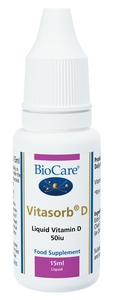
"About one in five people in the UK have a low blood level of vitamin D,” according to Professor Hilary Powers of the UK government’s scientific advisory committee on nutrition (SACN) into vitamin D.
So, the UK government has finally caught up to what health experts have been saying for years and are now recommending that we all boost our vitamin D levels – either by taking a supplement or by eating more fish and eggs – in order to protect our bone health and reduce the risk of bone disease. (see article)
Not just for the winter blues!
It’s no coincidence that lethargy and sluggishness are especially common during the colder months, as is increased susceptibility to seasonal bugs. This may be directly related to diminishing levels of vitamin D, as shorter days and colder temperatures usually mean less time spent outside and in the sun - and 90% of our vitamin D intake is produced when sunlight touches our skin.
But despite a growing awareness of the importance of vitamin D, many of us are still woefully low all year round – not just during the winter. In fact vitamin D deficiency is now considered a worldwide pandemic.
And there’s much more at stake than just flu and fatigue. Low levels of vitamin D can significantly affect other key aspects of our health.
Why is Vitamin D vital?
Bone Health – We need vitamin D to absorb calcium and fix it to our bones, so it’s long been associated with bone strength and protection from osteoporosis.
Mental Health – Vitamin D helps support mood and mental wellbeing. The connection between vitamin D deficiency and depression and SAD (seasonal effective disorder) is now well established.
Immune Health – Vitamin D has a vital role in cell division and is responsible for regulating hundreds of genes in our body. Mounting research showing that a deficiency makes are much more prone to heart disease, respiratory illness, autoimmune diseases and cancer. On the other hand, high levels appear to offer protection.
Subscribe to our newsletter
Why are we low in Vitamin D?
First of all, it’s a myth that food is a good source of vitamin D. Small amounts are found naturally in egg yolks, beef liver, cheese and oily fish (sardines, mackerel and salmon) and are added to a few others – fortified breakfast cereals and milks (too bad if you’re avoiding sugar, gluten and dairy).;
 Shiitake mushrooms are by far the best food source, but how many of us eat those on a regular basis?
Shiitake mushrooms are by far the best food source, but how many of us eat those on a regular basis? The sun has been highly demonised and we’ve become over-reliant on chemical sunscreens that protect our skin, but also inhibit the generation of vitamin D.
Certain people have a higher than normal requirement and so might be more at risk for Vitamin D deficiency than others: Pregnant, dark-skinned and older people need more. So do people with malabsorption conditions like coeliac and Crohn’s disease.
How much do you need?
Soaring rates of osteoporosis, rickets and immune diseases seem to confirm the fact that current vitamin D recommendations are likely too low for optimal health. As more and more scientific evidence emerges that vitamin D’s protective benefits kick in at levels much higher than those currently recommended many of the world’s leading experts on vitamin D are pushing for an upward review of minimum levels for adults and children alike.
In most countries anything below 75 nmols (nanomols) per litre of blood is considered ‘insufficient’ and anything between 75 and 150 nmols/L is considered ‘sufficient’. However, these guidelines are considered highly conservative by most of the world’s leading experts on vitamin D, who are pushing for an upward review in public policy that would put minimum levels at 125 nmols/L – for adults and children alike. After all, research shows vitamin D’s protective benefits kick in at 125nmols/L - not below.
Do you need to check your levels?
As a nutritionist I often see less than optimum vitamin D levels. If you think you might be low you have 2 options:
• Get your GP to test you.
• Get a home test kit from here (this is the cheapest option if you are in the UK)
• Alternatively, outside the UK try Genova diagnostics
Your levels should never go below 32 ng/ml and ideally should be between 50 – 70 ng/ml.
 How to make sure
How to make sure
Meanwhile, the best way to reach optimal vitamin D levels is with moderate sun exposure. 10 to 15 minutes on sunny days is enough for most light-skinned people. Darker skinned people will need more. Try to expose as much of your body as possible.
If you can’t be outside everyday, or find out you’re low, supplements are a good option. I recommend 1,000 - 1,500 iu daily for 3 months, (then check your levels again) or a single dose of 100,000 iu to quickly get your levels back up.
Vitamin D is too important to just assume you’re in the healthy range.
Have your levels tested regularly and make sure you and your family are covered – rain or shine!
Salade Nicoise Recipe
Try a simple but delicious sunshine; salad nicoise to boost your vitamin d


